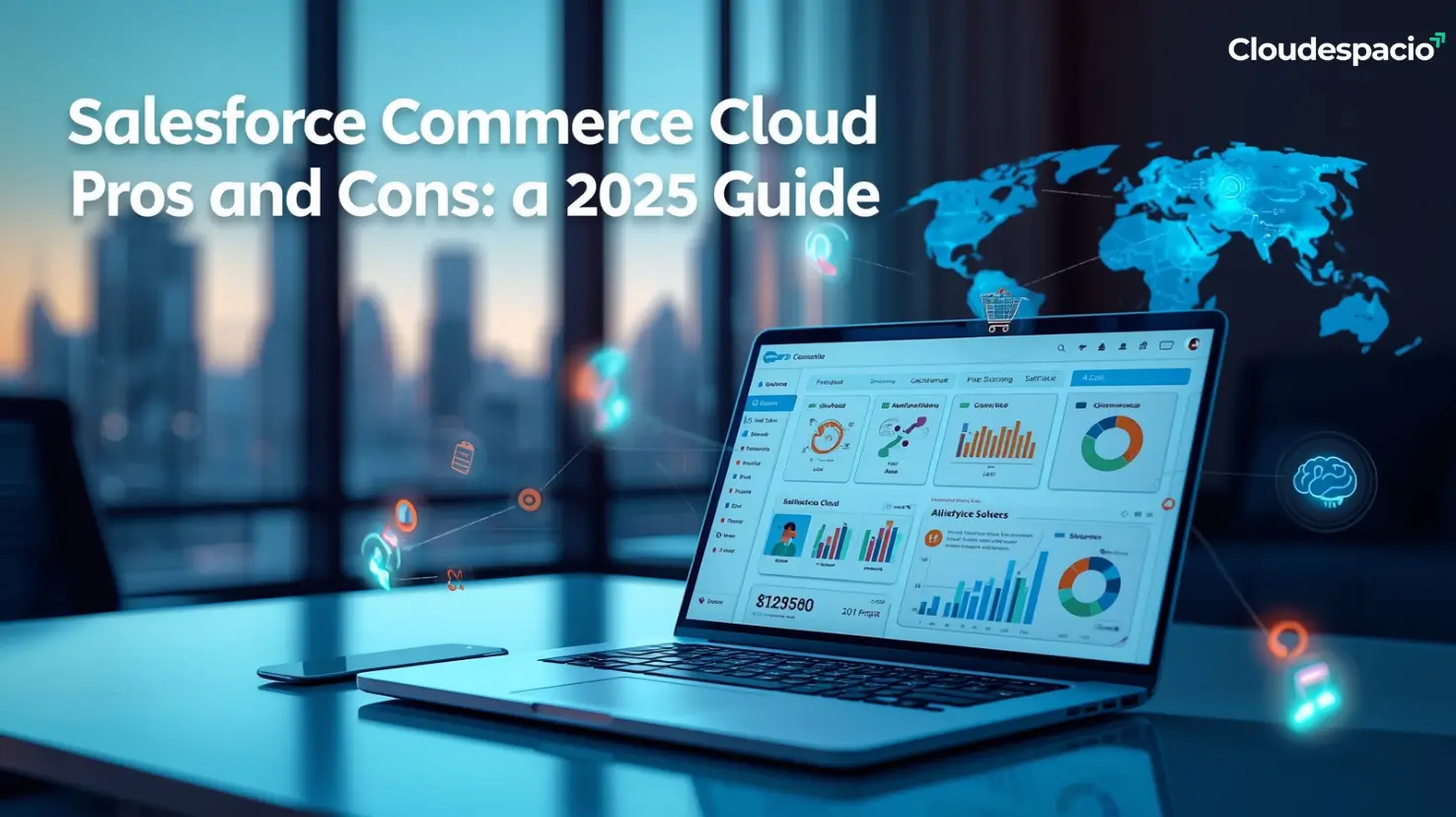


Choosing the right ecommerce platform is one of the most critical decisions for a growing business. Salesforce Commerce Cloud (SFCC) is a name that frequently comes up for brands aiming for the big leagues. It’s known for powering some of the world’s top retailers with its robust features and scalability and also Pros and Cons. But is it the right fit for everyone?
Making an informed decision requires looking beyond the sales pitch. This balanced guide will explore the Salesforce Commerce Cloud pros and cons, giving you a clear picture of what the platform offers and its potential challenges. We’ll cover key Salesforce Commerce Cloud features, discuss ecommerce scalability, and dive into the real cost of implementation, helping you decide if SFCC aligns with your business goals.
SFCC has earned its reputation as an enterprise-level powerhouse for several compelling reasons. Its strengths lie in providing the tools large-scale businesses need to create sophisticated, personalized shopping experiences.
One of the biggest advantages of SFCC is its incredible ecommerce scalability. The platform is built on a cloud-based infrastructure designed to handle massive traffic surges and large product catalogs without breaking a sweat. For businesses that experience high-volume periods like Black Friday or viral marketing campaigns, this is a game-changer.
You can operate with confidence, knowing your site will remain fast and responsive, providing a consistent experience for every shopper. This reliability allows your business to grow without worrying about outgrowing your platform’s technical limitations.
Salesforce’s integrated AI, called Einstein, is a standout feature that sets SFCC apart. This tool enables deep AI-driven personalization, helping you create unique shopping journeys for each customer. Einstein analyzes shopper behavior, purchase history, and real-time interactions to deliver:
By tailoring the experience, you can significantly increase engagement, boost conversion rates, and build stronger brand loyalty.
Today’s customers shop everywhere, on your website, through social media, on mobile devices, and in physical stores. SFCC excels at multi-channel selling, providing a unified platform to manage all your sales channels from a single dashboard.
This “omnichannel” capability ensures a consistent brand and shopping experience no matter where your customer is. You can manage inventory, pricing, and promotions across all channels, creating a seamless journey that allows customers to buy online and pick up in-store or browse on mobile and complete the purchase on a desktop.
SFCC comes packed with a wide array of advanced Salesforce Commerce Cloud features designed for serious retailers. The platform includes powerful tools for merchandising, marketing, and order management right out of the box.
Key features include:
While SFCC is powerful, it’s not without its drawbacks. These challenges are crucial to consider, as they can significantly impact your budget, resources, and timeline. Understanding the full scope of Salesforce Commerce Cloud pros and cons is essential.
The cost of Salesforce Commerce Cloud is one of its most significant barriers. It’s an enterprise-level solution with a price tag to match. The pricing model is based on a percentage of your Gross Merchandise Value (GMV), meaning the platform’s cost grows as your sales increase.
Beyond the licensing fees, you must also budget for:
For small to mid-sized businesses, these combined costs can be prohibitive, making other platforms a more practical choice.
Getting started with SFCC is not a plug-and-play process. The platform has steep implementation challenges and requires specialized technical expertise. Unlike simpler platforms like Shopify, you cannot set up a store over a weekend.
A typical implementation involves:
The Business Manager, SFCC’s admin dashboard is powerful but complex. For marketing and merchandising teams without a technical background, there is a steep learning curve. Simple tasks like updating homepage content or launching a new promotion can require developer assistance if not set up correctly.
This dependency can create bottlenecks and limit your team’s agility. While the platform offers immense flexibility, it comes at the cost of user-friendliness for day-to-day operations. Proper training and a well-thought-out implementation are essential to empower your business teams.
While SFCC is excellent for commerce, its native content management capabilities are limited. The platform does not have a built-in blog or an intuitive CMS for creating rich content pages. If content marketing is a core part of your strategy, this is a major drawback.
To overcome this, businesses often have to integrate a third-party headless CMS like WordPress or Contentful. This adds another layer of complexity and cost to your technology stack, and it’s a critical point to weigh in your analysis of Salesforce Commerce Cloud pros and cons.
So, should your business choose Salesforce Commerce Cloud? The answer depends entirely on your size, budget, and long-term goals.
Salesforce Commerce Cloud is a great fit if
You might want to consider other options if
Ultimately, choosing a platform is a strategic decision. By carefully weighing the Salesforce Commerce Cloud pros and cons, you can determine if its powerful features justify the investment in time and resources. For the right company, it is an unbeatable platform for growth. For others, a more accessible solution may be the smarter path forward.
If you are exploring a move to SFCC, partnering with an expert is key. Cloudespacio specializes in helping businesses navigate these complex decisions and implement solutions that drive real results.

Cloudespacio, headquartered in Singapore, is a prominent independent Salesforce and leading consulting firm, dedicated to prioritizing client satisfaction.
Copyright © 2025 All Rights Reserved. Designed by Navpatra.

If you have a project in mind, let’s talk!